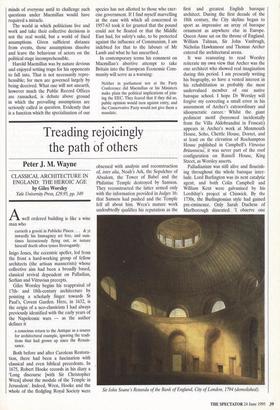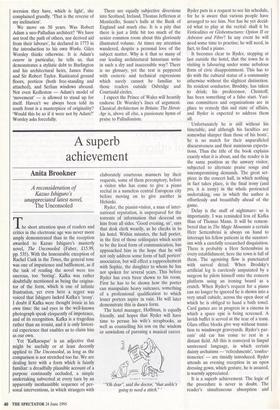Treading rejoicingly the path of others
Peter J. M. Wayne
CLASSICAL ARCHITECTURE IN ENGLAND: THE HEROIC AGE by Giles Worsley Yale University Press, £29.95, pp. 349 Awell ordered building is like a wise man who
carrieth a graviti in Publicke Places . . . & yt inwardly his Immagincy set free, and sum- times liccenciously flying out, as nature hirsealf doeth often tymes Stravagantly.
Inigo Jones, the eccentric speller, led from the front a hard-working group of fellow architects (the artisan mannerists) whose collective aim had been a broadly based, classical revival dependent on Palladian, Serlian and Vitruvian precepts.
Giles Worsley begins his reappraisal of 17th- and 18th-century architecture by pointing a scholarly finger towards St Paul's, Covent Garden. Here, in 1632, is the origin of a neo-classicism I had always previously identified with the early years of the Napoleonic wars — as the author defines it
a conscious return to the Antique as a source for architectural example, ignoring the tradi- tions that had grown up since the Renais- sance.
Both before and after Carolean Restora- tion, there had been a fascination with classical and even biblical precedents. In 1675, Robert Hooke records in his diary a `Long discourse [with Sir Christopher Wren] about the module of the Temple in Jerusalem'. Indeed, Wren, Hooke and the whole of the fledgling Royal Society were obsessed with analysis and reconstruction of, inter alia, Noah's Ark, the Sepulchre of Absalom, the Tower of Babel and the Philistine Temple destroyed by Samson. They reconstructed the latter armed only with the information provided in Judges 16: that Samson had pushed and the Temple fell all about him. Wren's mature work undoubtedly qualifies his reputation as the first and greatest English baroque architect. During the first decade of the 18th century, the City skyline began to sport as impressive an array of baroque ornament as anywhere else in Europe. Queen Anne sat on the throne of England. William Talman, Sir John Vanbrugh, Nicholas Hawksmoor and Thomas Archer entered the architectural arena.
It was reassuring to read Worsley reiterate my own view that Archer was the one architect who showed real imagination during this period. I am presently writing his biography, so have a vested interest in his rehabilitation as probably the most undervalued member of our native baroque school. I hope Dr Worsley will forgive my correcting a small error in his assessment of Archer's extraordinary and idiosyncratic career.. Whilst the, giant pediment motif (borrowed incidentally from the Villa Aldobrandini in Frascati) appears in Archer's work at Monmouth House, Soho, Chettle House, Dorset, and at least on the elevation of Roehampton House pttblished in Campbell's Vitruvius Britannicus, it was never part of the roof configuration on Russell House, King Street, as Worsley asserts.
Palladianism was still alive and flourish- ing throughout the whole baroque inter- lude. Lord Burlington was its next catalytic agent, and both Colin Campbell and William Kent were galvanised by his Lordship's project at Chiswick. By the 1730s, the Burlingtonian style had gained pre-eminence. Only Sarah Duchess of Marlborough dissented. 'I observe one Sir John Soane's Rotunda of the Bank of England, City of London, 1794 (demolished). aversion they have, which is light', she complained grandly. 'That is the reverse of my inclination'.
We move on 50 years. Was Robert Adam a neo-Palladian architect? 'We have not trod the path of others, nor derived aid from their labours', he declared in 1773 in the introduction to his own Works. Giles Worsley thinks otherwise. It is Adam's oeuvre in particular, he tells us, that demonstrates a stylistic debt to Burlington and his architectural heirs, James Paine and Sir Robert Taylor. Rusticated ground floors, porticos (both free-standing and attached), and Serlian windows abound. Not even Kedleston — Adam's model of `movement' — is allowed to stand up for itself. Haven't we always been told its south front is a masterpiece of originality? `Would this be so if it were not by Adam?' Worsley asks forcefully. There are equally subjective diversions into Scotland, Ireland, Thomas Jefferson at Monticello, Soane's halls at the Bank of England and much else. It is a pity that there is just a little bit too much of the senior common room about this gloriously illustrated volume. At times my attention wandered, despite a personal love of the subject matter. Why is it that so many of our leading architectural historians write in such a dry and inaccessible way? There is no glossary, yet the text is peppered with esoteric and technical expressions which surely cannot be familiar to those readers outside Oxbridge and Courtauld circles.
I expect the Prince of Wales will heartily endorse Dr Worsley's lines of argument. Classical Architecture in Britain: The Heroic Age is, above all else, a passionate hymn of praise to Palladianism.



























































 Previous page
Previous page